2016 Apátsági Juhfark
Somló, Hungary
Somló is Hungary’s smallest appellation and is the result of the erosion of ancient lava flows. A lone volcanic butte. Now dormant, its slopes of ancient sea sediment, hardened lava, and basalt are home to some of Hungary’s steepest, most densely planted vineyards. Driving up to Somló from Lake Balaton, it’s like seeing an island rise up from the ocean’s horizon. The oldest writings mentioning the wine of Somló date back to 1093 and viticulture all the way back to the Romans. Hungarian Kings bought vineyards here, Maria Theresa and Queen Victoria both praised the wines, and insurgent Hungarian troops fighting against the Habsburgs would solute the vineyards as they marched past at the end of the 17th century. In 1752, local laws stated that if you were found adding water to wine, expect 25 lashings as the minimum punishment. If you were found to be labeling wine as Somló but using other fruit sources, you would be banned from making wine permanently and might even have your property confiscated. Upon our last visit we were fortunate enough to run into Zoltán Balogh from Apátsági Winery. Their estate and cellar were originally owned by the Benedictine Pannonhalma Archabbey. After WWII, the land was expropriated and redistributed during Communism. It was brought back to life and replanted in 2001 with 5 people including the grandson of the last winemaker before the war. Zoltán’s grandparents were also local winemakers on the hill.
VINEYARDS
While the top of Somló hill is around 431 meters above sea level, Apátsági’s vineyards grow between 220-260 meters. While most of what they grow are stake trained (typical of Somló), the Hárslevelű is low cordon trained. Everything is dry farmed without herbicides or pesticides. All of the vineyards are on Southeast slopes planted in a mixture of clay, sand and the ubiquitous basalt. With 3 hectares total, the breakdown is 27% Furmint, 25% Juhfark, 25% Hárslevelű, 10% Olaszrizling, and 3% Traminer.
WINE MAKING
The red line that runs through all of their wines is picking for extreme ripeness, or what many in other regions would even call late harvest. If not for the incredibly high natural acidity these wines would be overly sweet and flabby. Grapes are hand picked and then spontaneously fermented in 600-2000 liter oak barrels. Wines are then aged in the same vessels for at least a year and then bottled unfiltered. SO2 only at bottling.

NOTES & PAIRINGS
This 100% Juhfark has a strong mineral character showing a fruity and floral nose and a vibrant and crisp palate. Delicious with charcuterie as well as pork and poultry dishes.
ANALYTICS & PRONUNCIATION
PRODUCER: Apátsági
APPELLATION: Somló (Shoam-low)
GRAPE COMPOSITION: %100 Juhfark
CLIMATE: Cool Continental
SOILS: Chalk and basalt “crumb
ALCOHOL: 13.6%
RESIDUAL SUGAR: 1.2 g/l
ACIDITY: 5.7 g/l
